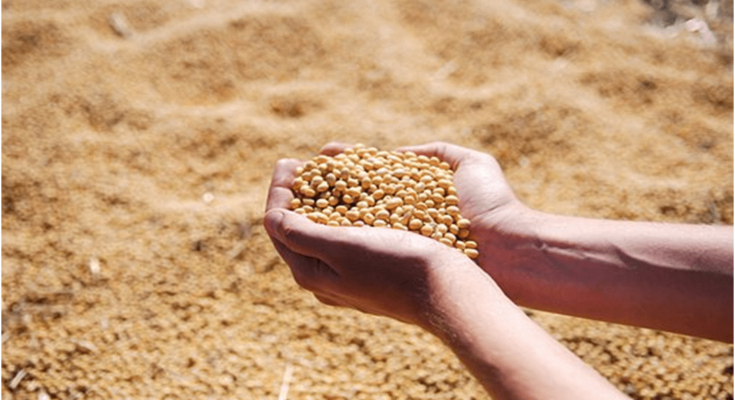Due to economic and market realities, some farmers may omit the regular crop rotation to increase their soybean plantings this spring. It might be dangerous to grow soybeans continuously. Deterrents include, but are not limited to, fears about disease and insects, yield drag, and other factors. According to research by Agronomy Journal, continuous soybeans had an average yield drag of 10.3%.
However, some methods may help to handle agronomic difficulties to maximize succeeding soybean yields. Some farmers believe continuous soybeans are a good alternative when prices are high. Farmers can cut the danger with appropriate management but not altogether remove it, which could position them for success.
Soybeans have specialized market potential since nutritionists like the legume for its advantages over other foods. They also give corn, which has issues, including resistance to corn rootworm management techniques and a rotating respite.
But this relies on how profitable soybean farming may be.
Here are five guidelines to follow throughout this year and beyond.
1. Spend Time on Variety Selection
Choosing and correctly placing the right varieties in your farming land is one of the essential tasks a farmer must do to maximize yield.
U.S. Soy farmers cultivate and create long-term remedies for the most important concerns of the day. These U.S Soy farmers are setting the bar high by growing more while using fewer resources, employing agricultural methods that lower carbon impact, and assisting in preserving forested areas.
Unfortunately, because there isn’t a reliable source of information, this is also one of the hardest processes. It is crucial to choose different varieties with various maturities, agronomic qualities, disease, pest resistance, and attributes that allow them to withstand herbicides. You should consult three to five seed firms.
Spend time poring over seed catalogs and discussing the qualities and attributes you want with salespeople and agronomists. Choose cultivars and maturity levels with the highest production potential, the best genetic makeup, and the best attribute combinations for your needs.
2. Plant Early
You’ve probably heard the saying, “cleanliness is akin to godliness.” Next to godliness, timing is also essential. According to numerous prominent agronomists, this unquestionably applies to planting soybeans.
Soybean planting could happen much sooner than you’d imagine if a field has adequate tiles.
Soybeans, for instance, should be planted in Indiana in late April or early May. Properly tiled fields aid this. Around this time, plant the beans if a farmer has had three to four days to sow maize.
The reason for this is that soybeans react to photoperiods. The more photosynthesis they can produce, which increases the potential output, the more sunlight they can absorb. Early growth also prepares the ground for forming roots and nodules, which supply adequate nitrogen for plants to keep leaves and fill seeds and pods.
3. Make Use of Spare Field Space to Create Test Plots
Create mini fields, alter the variables for each plot, and precisely record the changes when you benefit from the extra space. In the test plots, sow corn and corn but see which combination of factors produced the highest yield. Once you know the answer, you can immediately apply this knowledge to your primary growing areas and experience the same yield improvements.
4. Apply Dry Fertilizer (P&K)
Spreading P and K is profitable if you follow the instructions for applying lime every year to balance the pH. Soybean yields, on average, will increase. The pH of the soil is significant because it directly impacts how readily available the soil’s nutrients are to plants. The acidity or quantity of hydrogen ions in a soil solution is measured by its pH.
pH has an impact on a variety of chemical and biological soil activities. It can maximize the effectiveness of other crop inputs, and the chance of yield loss will be reduced by maintaining a suitable pH. A pH range of 6.0 to 6.8 is ideal for optimal soybean yield.
This way, you can ensure the availability of nutrients and increase production by maintaining correct soil pH levels. For healthy root development and growth, a proper soil structure is necessary. Soybeans are delicate to the chemicals in the soil. By lowering the prevalence of pests, diseases, and weeds, distance combined with plant density and crop rotation will enhance soybean yield. Controlling pests and diseases reduces damage to the root and leaf regions.
5. Practice Disease and Pest Management and Deploy Weed Control
Since the disease cycle isn’t interrupted by another crop, seedling diseases, including Phytophthora, Pythium, and Fusarium, might present more issues with continuous soybeans. The same is true of foliar ailments like frogeye leaf spots, brown spots, SCN, and sudden death syndrome (SDS).
Thus, for soybeans to continue to succeed, good pre-planting and in-season management are essential. During the growth season, check fields for disease and pest activity and treat them as necessary. With any ongoing crop, your management must improve. Ensure that soybean seed treatments have a solid disease package and choose defensive cultivars (fend off diseases better). Change varieties, trait packages, and chemical compositions to reduce future resistance problems.
If at all possible, begin with a clean field. Utilize many herbicide sites of action, treat weeds promptly, and utilize the recommended rates. Take into account a tiered residual program and meticulously scout.
To begin, use a freshly tilled field, and it is sprayed with a pre-emergent herbicide. If possible, treatments are made throughout the growing season to stop weeds from growing higher than an inch. Throughout the growing season, several residual herbicides are applied in layers. Real worries exist over the development of the weed seed bank and herbicide-resistant weeds. Switch to the Enlist platform after rotating chemistries and characteristics.
Final Note
Given the rising popularity of soybeans among vegans, diet-conscious people, and vegetarians, it becomes even more important to fulfill the increasing demands. So, these five tips can help boost soybean farm profits.


